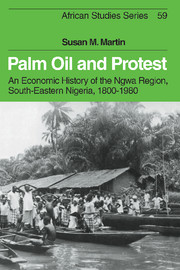Book contents
- Frontmatter
- Contents
- List of maps and figure
- Acknowledgements
- Abbreviations
- 1 Introduction
- 2 Ecology, society and economic change to 1891
- 3 The Ngwa and colonial rule, 1891–1914
- 4 The expansion of the oil palm industry, 1884–1914
- 5 The end of the boom
- 6 Cassava and Christianity
- 7 Authority, justice and property rights
- 8 Trade, credit and mobility
- 9 Production and protest: the Women Riot, 1929
- 10 Cash cropping and economic change, 1930–80
- 11 Conclusion
- Statistical appendix
- Notes
- Interviews conducted in the Ngwa region, 1980–1
- Bibliography
- Index
9 - Production and protest: the Women Riot, 1929
Published online by Cambridge University Press: 11 September 2009
- Frontmatter
- Contents
- List of maps and figure
- Acknowledgements
- Abbreviations
- 1 Introduction
- 2 Ecology, society and economic change to 1891
- 3 The Ngwa and colonial rule, 1891–1914
- 4 The expansion of the oil palm industry, 1884–1914
- 5 The end of the boom
- 6 Cassava and Christianity
- 7 Authority, justice and property rights
- 8 Trade, credit and mobility
- 9 Production and protest: the Women Riot, 1929
- 10 Cash cropping and economic change, 1930–80
- 11 Conclusion
- Statistical appendix
- Notes
- Interviews conducted in the Ngwa region, 1980–1
- Bibliography
- Index
Summary
For Ngwa women the 1920s saw an increase in labour burdens combined with growing threats to their autonomy in marketing and use of income. As the barter terms of trade for palm produce stagnated following the major decline of 1914–21, women struggled to maintain their incomes. Unlike junior men, they remained closely tied to food and palm production. At a time when the adoption of cassava was increasing their farming and cooking duties, they managed to increase their production of kernels and to retain control of the income obtained from selling them, and they began carrying oil and kernels to the railway trading agencies. However, as shown in Chapter 8, women's social roles and in particular their responsibility for spending on household needs had held them back from buying bicycles and joining the ranks of the enterprising and ambitious retail traders.
All this meant that as European firms became increasingly cartelised and introduced new pricing and measuring arrangements in the late 1920s, among the small Ngwa traders it was women who felt the changes most keenly. They relied upon income from produce sales, and had little opportunity to offset losses there with gains on the swings and roundabouts of retail pricing. Their one remaining consolation was their exemption from the direct tax which was levied on all Ngwa men from 1927.
In 1929 this small privilege – and with it the autonomy of the women's sphere within the male-administered colony – came under threat. At Oloko, women and children were counted by tax assessors; the revolt which followed spread like wildfire through the Ngwa and neighbouring regions and has become one of the most famous events in Nigerian history.
- Type
- Chapter
- Information
- Palm Oil and ProtestAn Economic History of the Ngwa Region, South-Eastern Nigeria, 1800–1980, pp. 106 - 118Publisher: Cambridge University PressPrint publication year: 1988

